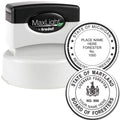Meet The Oil Resistant Inspection Stamp
If you’ve ever tried stamping an oily piece of equipment or a grease-covered part, you know how easy it is for your mark to smudge or fade. That’s exactly where an oil resistant inspection stamp comes in. This little tool helps you leave a crisp, lasting impression on surfaces that would usually reject standard ink. Whether you’re checking off items on a daily quality control list or verifying tight assembly lines, an oil-resistant solution can make your inspection process smoother and more dependable.
In this post, you’ll learn what sets these specialized stamps apart, why they matter for your workflow, and how to choose one that best fits your needs. Plus, you’ll find handy tips for maintenance and storage, so your investment lasts for the long haul. By the end, you’ll be well-equipped to choose and use an inspection stamp that won’t let you down in oily environments.
Recognize The Need For Oil Resistance
You might be wondering why you even need an oil-resistant stamp. Standard QA stamps tend to break down when they come into contact with greasy, lubricated parts. If you’re working in sectors like automotive, manufacturing, or heavy machinery, chances are your tools come face-to-face with oil on a daily basis. The last thing you want is for your stamped numbers or letters to vanish just because a little lubricant touched them.
An oil resistant inspection stamp offers ink that adheres firmly to slick surfaces. This means you’ll spend less time re-stamping the same item and more time moving on to your next task. Over the course of a busy day, that efficiency really adds up. If you rely on proper labeling for safety or record-keeping, you can’t afford to have your marks disappear under a film of grease.
Where You’ll Commonly Use It
- Assembly lines and factories
- Machine shops and tool repair stations
- Auto garages and tire shops
- Food processing plants handling oils or greases
- Any environment where surfaces are prone to slick residues
Why It Makes A Difference
- Provides consistent, legible results
- Reduces wasted time and repeated markings
- Minimizes errors in QA, QC, and safety checks
- Fosters a professional look for outsourcing or audits
Consider Key Features Before Buying
Once you realize you need an inspection stamp that can handle a bit of mess, it’s easy to assume all oil-resistant solutions work the same way. However, not all stamps are created equal. Different industries require different designs, ink formulations, and stamp bodies. Let’s explore some core features you’ll want to keep in mind.
Stamp Durability And Construction
Not every environment is gentle. Some inspection stations involve repeated high-pressure stamping, traveling around a busy floor, or getting tossed in a toolbox after each shift. In that case, a fragile plastic body simply won’t last. Look for a stamp made with sturdy materials like metal or heavy-duty plastic. Balance that with a comfortable grip if you’re stamping hundreds of times per day.
Ink Composition
At the heart of an oil-resistant stamp is the specialized ink. Some inks are formulated to repel oils or cure quickly upon contact, making them less likely to smear. Others use a fast-drying chemical base that bonds to metal or rubbery surfaces. Ask about how quickly the ink sets, the recommended surface prep (such as wiping off major debris), and any additional finishing or drying steps you need.
Customizable And Refillable
If your inspection process includes stamping unique codes or text, a customizable face plate is key. Instead of generic phrases like “Approved” or “Inspected,” you might prefer a specific stamp with your company name, date code, or shift number. Being able to refill the ink or swap out components is also handy if your operation changes over time.
Supplier Reputation
A small detail but majorly important is who you’re buying from. You deserve more than just a random stamp maker. A brand with a proven track record for quality, like ESS, can help you not only choose the right design, but also provide great customer service if something ever goes wrong. After all, you need confidence in both the product and the people behind it.
Explore Different Ink Formulations
In many cases, you’ll find oil-resistant stamps sold with industrial ink that’s designed to take on lubricated surfaces. But is one formula the same as another? Not exactly. Here’s a quick look at some ink types you might encounter:
- Solvent-Based Ink
- Dries quickly
- Often highly resistant to oil and water
- May require careful ventilation during use
- Permanent Quick-Dry Ink
- Designed to adhere to various nonporous surfaces
- Typically fade-resistant but can vary by brand
- May need a few extra seconds to fully cure
- Pigment-Based Ink
- Rich color saturation
- Good for stamps where color clarity is vital
- May dry more slowly than solvent-based options
- UV-Curing Ink (Less Common)
- Cures under UV light for immediate dryness
- Usually limited to specialized stamping machines
Knowing the differences helps you choose the ink that fits your environment. If you’re in a hurry, a quick-dry formula is your best bet. If color clarity matters, opt for pigment-based. Meanwhile, if you have a well-ventilated workshop, solvent-based ink can give you a superb, long-lasting impression on oily parts.
Use And Care For Your Stamp
How you use your oil resistant inspection stamp can make all the difference. It’s not just about pressing down and hoping for the best. With a little care, your stamp will function effectively for years.
Prep Your Surface
Even though your stamp is built to handle oil, don’t make it harder than it has to be. A quick wipe of the surface area reduces any excess lubricant so the ink can set properly. You don’t have to remove every last drop, but less oil means a neater, crisper mark.
Consider Pressure And Technique
Press firmly and evenly when stamping. Avoid tilting the stamp or slamming it into the object. If you’re marking a curved or irregular surface, a gentle roll of the stamp might be needed so the entire face contacts the item. Practice a few times on scrap material or less-important parts to find the sweet spot.
Allow Adequate Drying Time
Even oil-resistant ink needs a bit of time to fully cure. Rushing can smear the impression and defeat the purpose. If you’re on an assembly line, plan a staging area where freshly stamped parts can rest for a moment before moving to the next phase.
Keep It Clean
After a day’s work, wipe off any build-up on the stamp surface, especially if you’ve been stamping heavily oiled parts. This prevents caked-on residue that can lead to inconsistent markings over time. A gentle cleaning solution, designed for stamps, is usually all you need. Just remember to dry everything before storing it.
Check Out Custom Options
Whether you’re tackling day-to-day quality control tasks or you just love the idea of personalized labeling, going custom can be a nice upgrade. A custom oil resistant inspection stamp lets you incorporate specific text, your own codes, or even a unique design. Having a specialized mark can streamline your record-keeping and reinforce your brand at the same time.
Looking to make your company name more visible? You can also look into a company logo inspection stamp. Having a branded inspection mark isn’t just about style. It can help you stand out if you’re shipping parts to various clients or need to differentiate your products from competitors.
Meet ESS: Your Trusted Stamp Partner
Choosing the right oil-resistant solution is simpler when you have a reliable partner. At ESS, we’ve been family owned and operated since 1964, putting decades of stamp know-how right at your service. Our excellent customer support means you’ll always have someone to chat with about your needs and preferences. We also pride ourselves on a very fast turnaround, so you won’t be left waiting on the tools you need to keep your operation running.
We don’t just carry off-the-shelf inspection stamps. We’re known for custom inspection stamps, QA stamps, QC stamps, and everything in between. If you want something that fits your specific industry requirements, ESS is here to help. You’ll find top-notch suppliers and knowledgeable staff who can guide you in selecting exactly the right stamp body, ink type, and mark size.
Compare Types And Pricing
Sometimes, it helps to see what you’re dealing with side-by-side. Below is a short table summarizing common stamp types, their usual price ranges, and a brief note on what makes them stand out. Keep in mind, these ranges are just general ballparks to give you an idea:
| Stamp Type | Price Range (USD) | Key Advantage |
|---|---|---|
| Standard Rubber Stamp | 5–15 | Simple, affordable, best for papers |
| Self-Inking Stamp | 15–30 | Built-in ink pad, convenient |
| Oil-Resistant Self-Inking | 30–50+ | Specialized ink, stands up to grease |
| Custom Inspection Stamp | Varies | Tailored design, brand consistency |
Prices can fluctuate based on brand, size, and customization level. But it’s never money wasted when you invest in the right tool for the job. Cheaper stamps might require frequent replacements or extra time re-stamping items, which can cost you more in the long run.
Find The Right Source
Once you’re set on buying an oil resistant inspection stamp, track down a provider known for quality and reliability. That’s where ESS comes in. From choosing the correct ink formula to personalizing your stamp face, we’ll walk you through each step. You can relax knowing you won’t be left guessing when it comes to re-inking or maintenance. Our team is only a phone call away if you have any questions.
What ESS Brings To The Table
- Over half a century of experience
- Personalized consultation to match your specific needs
- Swift turnaround times for both small and large orders
- Family-run approach that treats you like part of the ESS family
Summary And Next Steps
An oil resistant inspection stamp can be your secret weapon for marking greasy, lubricated, or otherwise challenging surfaces. By picking a sturdy stamp body and pairing it with specialized ink, you’ll get crisp marks that stay legible longer. Remember to clean your stamp regularly, allow proper drying time, and keep an eye on your ink levels.
Whether your work involves motor parts, factory lines, or any environment where oil is part of the daily routine, an oil-resistant stamp spares you the headaches of faded or smeared marks. Ready to order yours? Start by jotting down your specific requirements: what surfaces you stamp, how often you use it, and whether you need custom text or logos. Then, connect with a reputable supplier like ESS to bring that vision to life.
Frequently Asked Questions
Do I need to prep the surface even if the stamp ink is oil-resistant?
Yes. Although oil-resistant ink can handle grease, a quick wipe to remove excess oil helps the ink bond to the surface more effectively.How long does the ink usually last on an oily surface?
It depends on the brand and formulation, but most high-quality, oil-resistant inks hold up for a significant period. Some can last months or even years in less abrasive environments.What if my inspection process changes and I need a different design?
That’s where a customizable stamp comes in handy. With a service like ESS, you can easily adjust your text plate or switch inks to match new requirements.Can I use the same ink pad for standard and oil-resistant ink?
It’s best to keep them separate. Mixing inks might compromise the special properties of the oil-resistant formula or reduce its effectiveness.Is an oil-resistant stamp only for industrial use?
Not necessarily. Any setting with lubricated or slippery surfaces, like automotive shops or certain food-processing areas, can benefit from an inspection stamp that won’t smudge or wash away.
Feel more confident about tackling oily surfaces? Go ahead and explore your options for an oil resistant inspection stamp. With the right setup, those messy, grease-prone parts won’t scare you—or your stamp—ever again. And if you need any help customizing your order or choosing the right ink, the friendly folks at ESS are just a call away. Happy stamping!


















